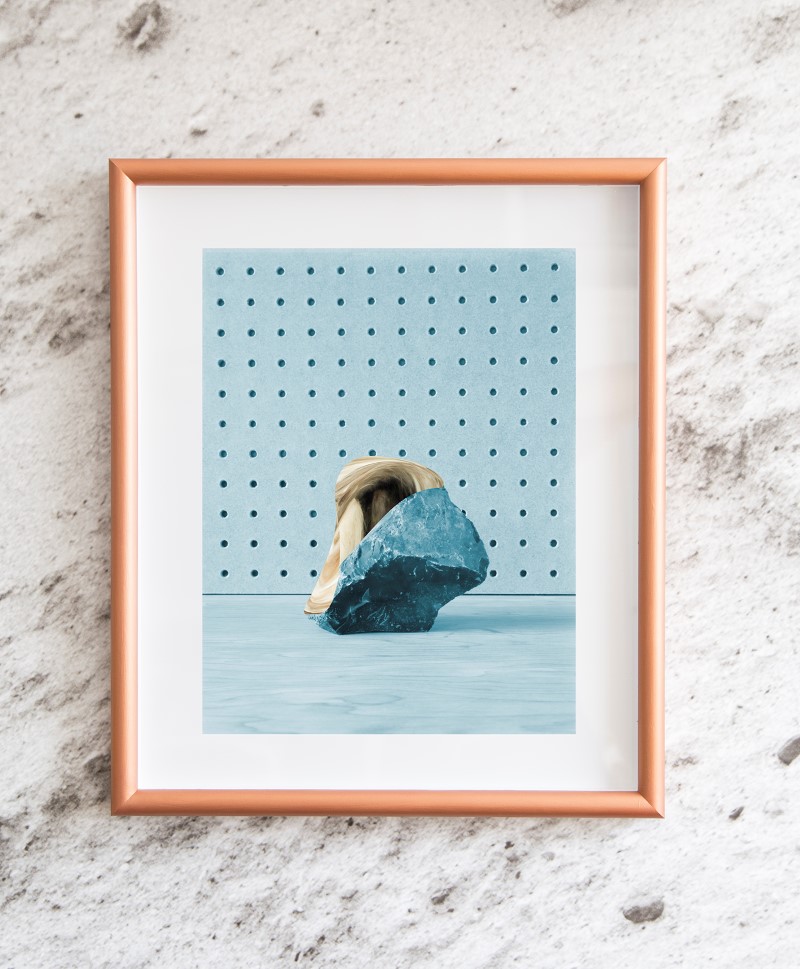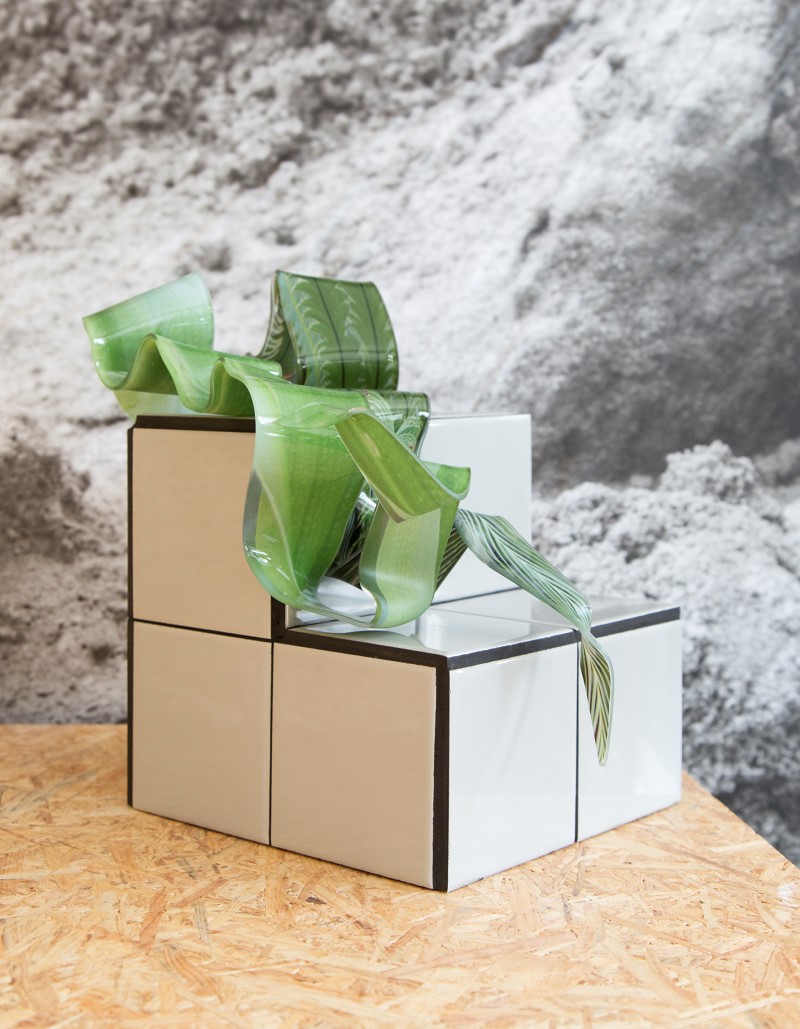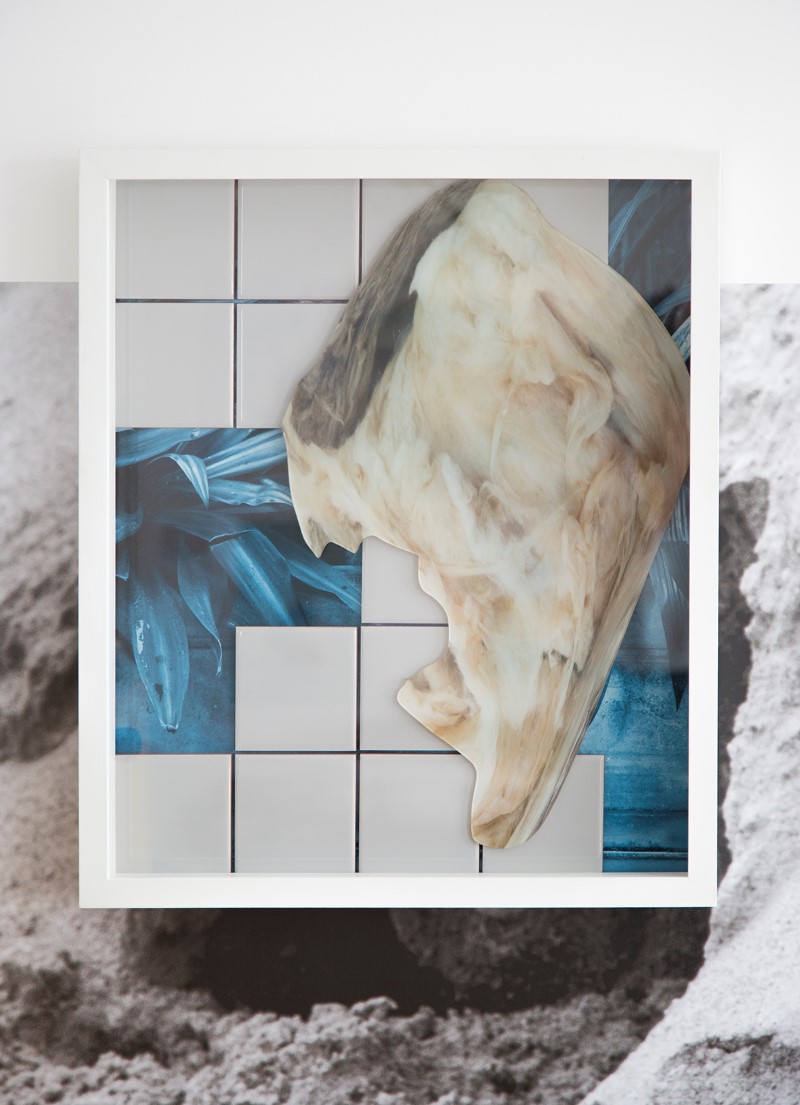“I tend to find that my sculptural work comes from far clearer visions before they are constructed. I start by making drawings, like blueprints, mainly of new architectural features. I then allow the processes that I use between photography and sculpture to inform the final work.”
Fanny Landström with Felicity Hammond, ASX, September 2015
A large photographic collage with images of industrial decay and urban development printed onto a wooden canvas. Stylistically mimicking the slick visuals of advertising in hues of light blue and faded pink. Sculptures, digitally simulated vegetation inkjet printed onto vinyl, functioning as relics of former industry now turning into luxury housing. British artist Felicity Hammond is represented by South Kiosk Gallery, London. They will be exhibiting her works “Capital Growth” (2015), and “You Will Enter An Oasis” (2015) at this years Unseen Photo Fair in Amsterdam.
FL: I find it quite overwhelming looking at your work and realizing what a long, and thorough, process they’ve must have gone under before final materialization… Photographing over time, making collages, and creating sculptures… Consider materials, measures, and display… patience and determination… How long have you been working on Capital Growth that now is exhibited at Unseen?
FH: Capital Growth is the first project that I have undertaken since graduating from my Masters at the Royal College of Art. I was lucky to be nominated for the Catlin Art Prize straight after graduation, which supported me in making a new, ambitious work. I worked on this collage in particular over the space of around 6 months, although perhaps I made some of the photographs that make up the final image previously to this. I have a large archive of imagery that I work with, that I have been building on over a long time. Sometimes I dip into shoots that I might have made 2 or 3 years ago. So, in terms of the length of time it takes to make such a work, it is quite difficult to really measure. Capital Growth has existed in fragments of imagery and in my imagination for an unspecified amount of time.
FL: And do you have a clear vision of the final piece in mind when beginning the process, or does the process fully determine the outcome?
FH: Both my collages and photo-sculptures ‘emerge’ through process. However, I do always begin with a vision, in some sense. For example, before making Capital Growth, I had become quite obsessed with the small portholes that allow passers-by to view new constructions in the city. They are often placed fairly surreptitiously, embedded in the adverts that shroud building sites. This was my starting point, so when building this collage I began making sketches that used the porthole as a main feature. I also draw a lot of my visual inspiration from baroque painting, and I used Rubens’s “The Great Last Judgement” as a compositional reference.
I tend to find that my sculptural work comes from far clearer visions before they are constructed. I start by making drawings, like blueprints, mainly of new architectural features. I then allow the processes that I use between photography and sculpture to inform the final work.

Anthracite Peru

Bermuda Grass (Modular Versatility)

You Will Enter An Oasis (Off-plan)
“These works sit somewhere between the archaic and futuristic, where time is striated. The violence in the gaps provides ground for the fragment or the incomplete, creating another time or place; a portal which provides the viewer with a place to mourn. We are faced with both ruin and construction, and this duality of course alludes to allegory.”
FL: I get a sense that you’re somewhat of a perfectionist… What is your relationship to perfectionism (especially in relation to the creative process and production)?
FH: Assuming that ‘perfectionism’ is relating to the material quality of the work that I make, I guess that I am mimicking the slick exteriors of new architectural features in the city; from corporate buildings to folly-esque monuments for private gated penthouses. These, on the surface, are ‘perfect’ in the sense that they promote a certain type of life-style – one that can be attained when housed within the trademark glossy exterior of the ‘boutique development’.
In terms of perfectionism within my process, these works actually emerge from a studio full of raw materials, tests, found objects, drawings, and old photographs. I never feel that I reach perfectionism, but I suppose that’s what a perfectionist might say. I never actually feel that my collages are complete – I work on them until there is some kind of deadline. If I didn’t have any shows, I would probably work on them forever.
FL: Many of your projects seem to touch on topics such as urban landscape and development, industrial evolution, and capital in relation to the city and the people within it… What is the general conceptual framework behind Capital Growth?
FH: Capital Growth explores a space in which reality is fused with the virtual world; an area where manufacturing and industrial process has been discarded, and in its place stands computer generated imagery of luxury living, where posters pertain to a better life and a better future. This place is utopic yet grotesque – it cultivates a growth fetish, where capitalism is constantly defined and redefined. Full of paradox, it talks of an unobtainable capital, a capital that proliferates without labour. I really wanted to find a way to show the way in which these sites that were once producers of power have now become a product of it. The work therefore stands for both progression and error, and its relationship with urban temporality.
FL: Through much of your work there also seem to be an aspect of temporality that almost has a sentimental feel to it. Its like the concept of time and development is a malicious source to loss, or to the losing of the past…
FH: These works sit somewhere between the archaic and futuristic, where time is striated. The violence in the gaps provides ground for the fragment or the incomplete, creating another time or place; a portal which provides the viewer with a place to mourn. We are faced with both ruin and construction, and this duality of course alludes to allegory. So, this loss of the past – of industry and manufacturing, and the rise in technology – of capital in the city, might be a realm that is provided to hide rather than reveal meaning. For me, the works go beyond just addressing the changing socio-political landscape, but use the fabric of the city to explore loss in a more autobiographical sense, with particular reference to my family’s relationship with industrial decline.
FL: Why Unseen?
FH: I find art fairs to be a particularly challenging and strange context for my work to be shown in. This is mainly due to the large scale and installation-based approach that I take. However, Unseen (although this will be my first time at this fair) seems to take a less conservative approach to both photography and display methods, and therefore I hope that it will provide a more appropriate platform for my work.
http://unseenamsterdam.com/photographers/3889
(All rights reserved. Text @ Fanny Landstrom and ASX. Images @ Felicity Hammond.)












